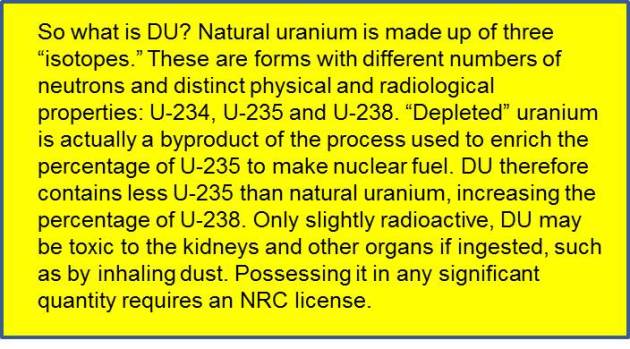Jefferson Proving Ground – the NRC’s Rolehttp://public-blog.nrc-gateway.gov/2014/12/22/jefferson-proving-ground-the-nrcs-role/?source=govdelivery&utm_medium=email&utm_source=govdelivery
Posted by on December 22, 2014
Senior Environmental Project Manager
Most people think of nuclear reactors when they think of the NRC. Some may think of nuclear medicine or uranium. Many would be surprised to know we are also involved in regulating radioactive materials at U.S. military sites.
Although nuclear weapons are completely outside our purview, some military sites need an NRC license to possess and use certain nuclear materials. For example, the Army has a license to possess depleted uranium (DU) at a site in Indiana called Jefferson Proving Ground.
The Army began using the 56,000-acre site in 1941 to test fire all sorts of conventional munitions. The Army fired more than24 million rounds before testing came to an end in 1994 and the installation closed in 1995 as a result of the Base Realignment and Closure Act. Today, the Army still owns about 51,000 acres of the original site, but nearly all of that is managed as a wildlife refuge. The Indiana Air National Guard uses another part of the site as an air-to-ground bombing training range. The 51,000-acre area contains unexploded ordnance —explosive munitions that could still go off—and live detonators, primers and fuzes, and can’t ever be used for farming, housing or commerce.
 In
the early 1980’s, the NRC got involved with the site when the Army
wanted to test DU rounds there. The DU in these rounds is able to
penetrate the armor on a tank. Over a 10-year period, the Army fired
about 220,000 pounds of DU projectiles into a 2,080-acre area known as
the DU Impact Area. The Army still has its NRC license for the DU and
now wants to decommission the DU Impact Area, which lies within the
51,000 acres with unexploded ordnance.
In
the early 1980’s, the NRC got involved with the site when the Army
wanted to test DU rounds there. The DU in these rounds is able to
penetrate the armor on a tank. Over a 10-year period, the Army fired
about 220,000 pounds of DU projectiles into a 2,080-acre area known as
the DU Impact Area. The Army still has its NRC license for the DU and
now wants to decommission the DU Impact Area, which lies within the
51,000 acres with unexploded ordnance.The Army has proposed a plan for decommissioning. It has asked the NRC to terminate the license, with certain restrictions as allowed under our regulations. The NRC is in the early stages of reviewing the proposal.
About 162,000 pounds of DU remain in the DU Impact Area. There is also a high density of unexploded ordnance in this area. The Army proposes to leave the DU and unexploded ordnance in place because cleanup would be very dangerous and very expensive. To keep people out of the Jefferson Proving Ground site, the Army says it will keep the current access barriers—including a perimeter fence with padlocked gates and security warning signs—as well as legal and administrative controls.
The NRC met with the public near the site in early December to discuss the Army’s request. We wanted to hear people’s comments and concerns about the environmental aspects of the Army’s plan. We transcribed the meeting to record these statements. We have also taken written public comments.
And, we will consider this input during our independent review of the Army’s proposal. Our analyses and conclusions will be documented in a draft Environmental Impact Statement that explains everything we looked at. We’ll publish the draft for comment and discuss it at a future public meeting. We will consider all the comments we receive on the draft as we put together a final Environmental Impact Statement. The final document will discuss the comments and how we addressed them.
Our process also includes a separate review of the safety impacts of what the Army is proposing. We will publish those findings in a Safety Evaluation Report. Once both the environmental and safety reviews are complete, we will be able to make a decision on the Army’s request.
Local residents told us they want the Army to monitor the environment even after the license is terminated. Others told us they want the Army to clean up the site. Our environmental review will look at those alternatives. People were also concerned about radiation. Our review will make sure the Army’s plan meets all NRC requirements to protect public health and safety.

No comments:
Post a Comment